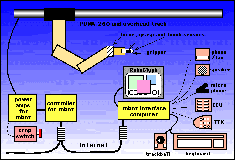Investigators: H.F. Machiel Van der Loos, PhD and Charles G. Burgar, MD Project Staff: Inder Perkash, MD; Michael Wickizer, PT; James J. Wagner, MS; Kyong S. Chang, PhD; and Niels Smaby, MS Project Category: Spinal Cord Injury - 2000 Introduction: The ProVAR (Professional Vocational Assistant Robot) system is an assistive robot that enables individuals with a physical disability such as high-level tetraplegia to manipulate physical objects in a semi-structured office workstation environment. ProVAR allows its users to create and execute Activities of Daily Living (ADLs) and vocational support tasks that are complex yet robust. Findings: The robot arm, mounted overhead on a transverse, motorized track, can execute tasks created through commands given by the user, who manipulates a 3-D graphic representation of the workstation. This project developed a novel user interface and dynamic control environment that allows for robust, safe, sensor-based control of the manipulator. The user previews the task on-screen in a live dynamic simulation of the robot calcu-lated by the robot arm's controller before final execution of the task by the arm. The ProVAR interface combines a task creation and manipulation window with the 3-D world model. The user interacts with the ProVAR system through various adaptive access devices selected according to each user's specific physical capabilities and prefer-ences. The ADL and vocational manipulation tasks that ProVAR can perform (medication, drinks, paper handling, disks, videotapes, etc.) allow the user to be without an attendant for a large portion of a working day, increasing overall independence and permitting a measure of personal privacy. Testing: User testing has aided in refining the interface and confirming the success of the design strategy. The test subjects were able to execute pre-programmed tasks and create new ones after two training sessions. It was highly motivating for the test subjects to watch the robot arm perform a task in real life that they had created and tested on-screen in simulation. Publications: J.J. Wagner, H.F. Machiel Van der Loos, Larry J. Leifer, Construction of social relationships between user and robot, Robotics and Autonomous Systems (31), pp. 185-191, 2000. J. Joseph Wagner, Michael Wickizer, H.F. Machiel Van der Loos, Larry J. Leifer,. User testing and design iteration of the ProVAR user interface. Proc., 8th IEEE International Workshop on Robot and Human Communication (RO-MAN), Pisa, Italy, Sept. 27-29, 1999. J.J. Wagner, M. Wickizer, H.F.M. Van der Loos, L.J. Leifer, User testing and design iteration of the ProVAR user interface, Proceedings, 6th International Conference on Rehabilitation Robotics (ICORR'99), Stanford, CA, July 1-2, pp. 250-254, 1999. H.F.M. Van der Loos, J.J. Wagner, N. Smaby, K.-S. Chang, O. Madrigal, L.J. Leifer, O. Khatib, ProVAR assistive robot system architecture, Proc. ICRA, May 10-15, Detroit, MI, 741-746, 1999. HFM Van der Loos, JJ Wagner, N Smaby, K-S Chang, O Madrigal, LJ Leifer, O Khatib, ProVAR rehabilitation robot system architecture, Proc. RESNA'99, June 26-30, Long Beach, 134-6, 1999. J.J. Wagner, H.F.M. Van der Loos, L.J. Leifer, Dual-character based user interface design for an assistive robot, Proc., 7th IEEE International Workshop on Robot and Human Communication (RO-MAN), Takamatsu, Japan, Sept. 30 - Oct. 2, pp. 101-106, 1998. Related Work:
Funding Source: VA RR&D Merit Review |
